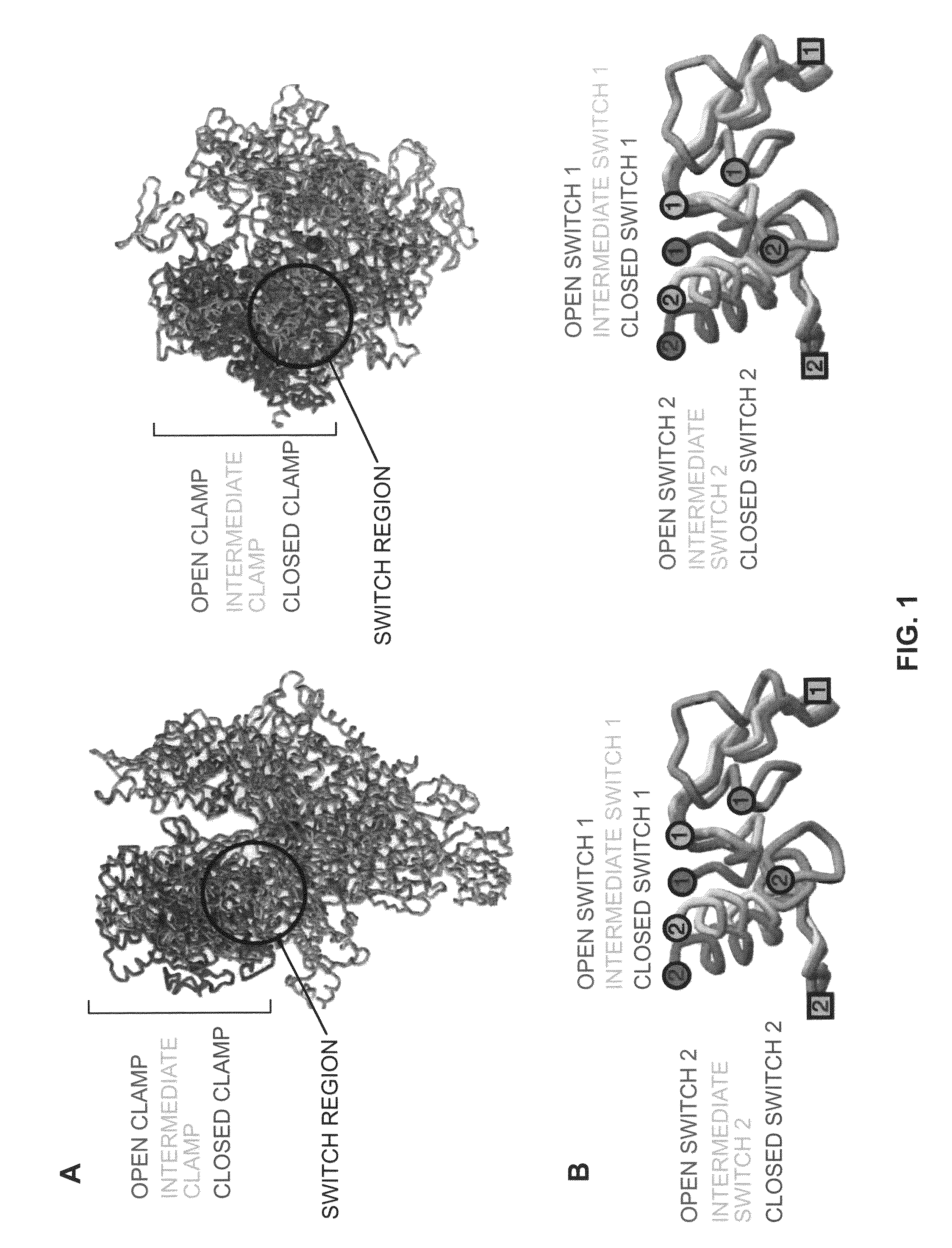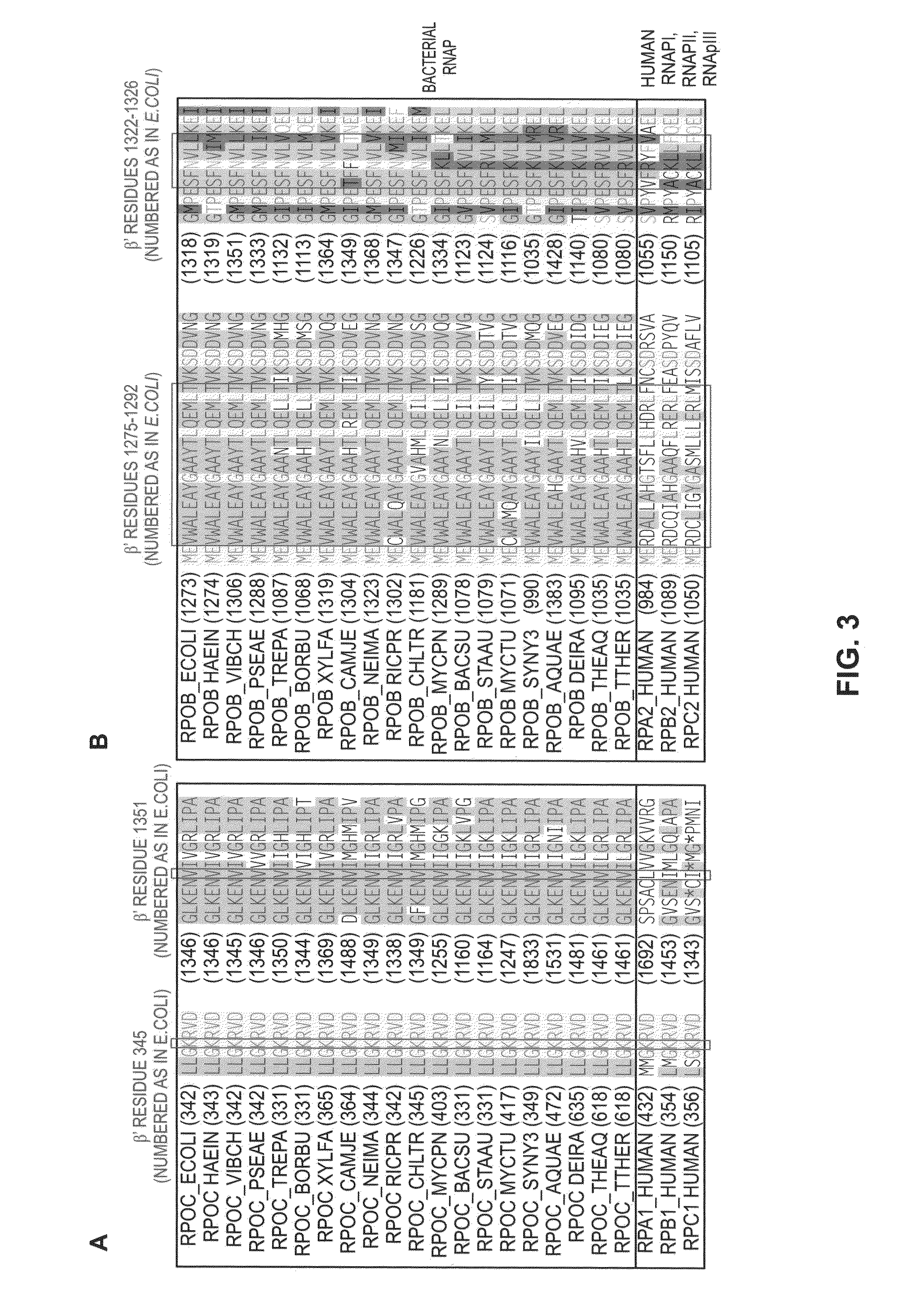Switch-region: target and method for inhibition of bacterial RNA polymerase
a technology of rifamycin and target region, applied in the direction of instruments, peptides, enzymology, etc., can solve the problems of threatening the clinical utility of rifamycin antibacterial agents, infections that pose a grave and growing threat to public health, etc., and achieve broad-spectrum antibacterial activity
- Summary
- Abstract
- Description
- Claims
- Application Information
AI Technical Summary
Benefits of technology
Problems solved by technology
Method used
Image
Examples
example 1
Switch-Region-Target Inhibitors: MYX
[0136]The present example is directed to the use of myxopyronin (Myx) as a small-molecule inhibitor of bacterial RNAP that, based on Applicant's discovery, functions through interaction with the bacterial RNAP homologous amino-acid sequence.
[0137]Myx is a polyketide-derived α-pyrone antibiotic (Irschik, et al. (1983) J. Antibiot 36, 1651-1658; Kohl, et al. (1983) Liebigs Ann. Chem. 1656-1667; Kohl, et al. (1984) Liebigs Ann. Chem. 1088-1093; FIG. 4). Myx is produced by Myxococcus fulvus strain Mxf50 (DSM 2549; Irschik, et al. (1983) J. Antibiot 36, 1651-1658). The compound inhibits growth of Gram-positive and Gram-negative bacterial species, including Bacillus subtilis, B. megaterium, Staphylococcus aureus, Micrococcus luteus, Enterococcus faecium, Enterobacter cloacae, Corynebacterium mediolanum, Mycobacterium smegmatis, Acinetobacter calcoaceticus, Pseudomonas aeruginosa, and Escherichia coli DH21tolC (MICs≦10 μg / ml for all; MICs≦1 μg / ml for S. ...
example 2
Switch-Region-Target Inhibitors: COR
[0154]The present example is directed to the use of corallopyronin (Cor) as a small-molecule inhibitor of RNAP that, based on Applicant's discovery, inhibits RNAP through interaction with the bacterial RNAP homologous switch-region amino-acid sequence. Cor is a polyketide-derived α-pyrone antibiotic structurally related to Myx, differing only by possession of a seven-carbon side-chain extension (Irschik, et al. (1985) J. Antibiot. 38, 145-152; FIG. 4A,B). Cor is produced by the myxobacterium Corallococcus coralloides strain Cc c127 (DSM 2550; Irschik, et al. (1985) Supra). The compound potently inhibits growth of Gram-positive and Gram-negative bacterial species, including Bacillus subtilis, B. megaterium, S. aureus, M. luteus, C. mediolanum, and Escherichia coli DH21tolC (MICs≦10 μg / ml for all; MIC≦0.1 μg / ml for S. aureus; Irschik, et al. (1985) Supra; unpublished data). The compound is bacteriocidal, as assessed in experiments with Escherichia c...
example 3
Switch-Region-Target Inhibitors: RIP
[0159]The present example is directed to the use of ripostatin (Rip) as a small-molecule inhibitor of RNAP that, based on Applicant's discovery, inhibits RNAP through interactions with the bacterial RNAP homologous switch-region amino-acid sequence. Rip is a polyketide-derived macrocylic-lactone antibiotic (Irschik, et al. (1995) J. Anitibiol. 48, 787-792; Augustiniak, et al. (1996) Liebigs Ann. 10, 1657-1663); FIG. 4C). Rip is produced by the myxobacterium Sorangium cellulosum strain So ce377 (DSM 7291; Irschik, et al. (1995) Supra). The compound potently inhibits growth of Gram-positive and Gram-negative bacterial species, including S. aureus, and Escherichia coli DH21tolC (MICs≦1 μg / ml; Irschik, et al. (1995) Supra; unpublished data). The compound is bacteriocidal, as assessed in experiments with Escherichia coli DH21 tolC (unpublished data). The compound inhibits bacterial RNAP (Ki=0.3 μM) but does not inhibit eukaryotic RNAP II (Irschik, et a...
PUM
 Login to View More
Login to View More Abstract
Description
Claims
Application Information
 Login to View More
Login to View More - R&D
- Intellectual Property
- Life Sciences
- Materials
- Tech Scout
- Unparalleled Data Quality
- Higher Quality Content
- 60% Fewer Hallucinations
Browse by: Latest US Patents, China's latest patents, Technical Efficacy Thesaurus, Application Domain, Technology Topic, Popular Technical Reports.
© 2025 PatSnap. All rights reserved.Legal|Privacy policy|Modern Slavery Act Transparency Statement|Sitemap|About US| Contact US: help@patsnap.com



